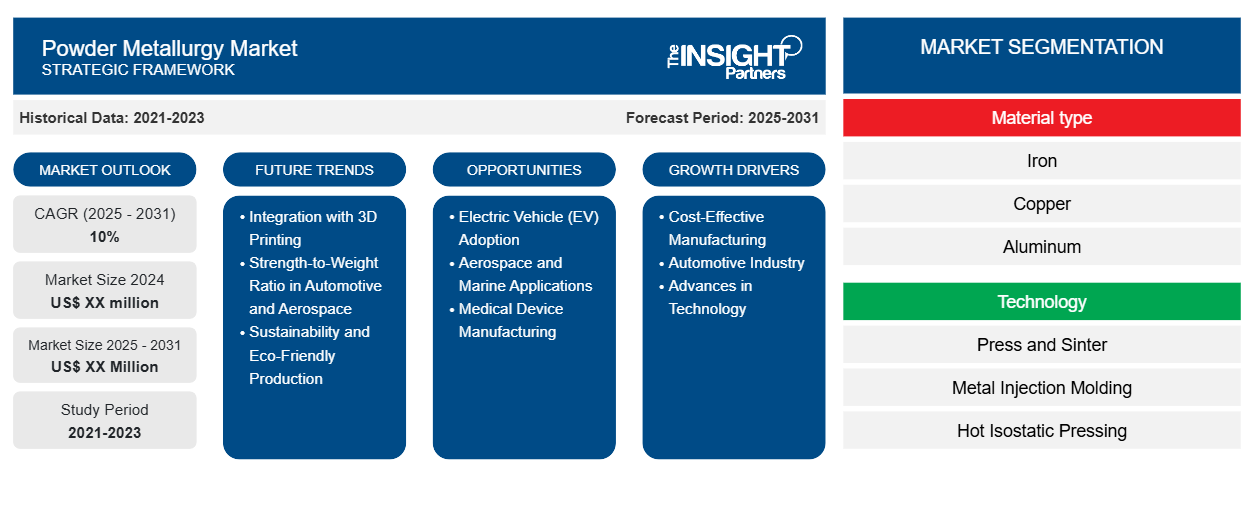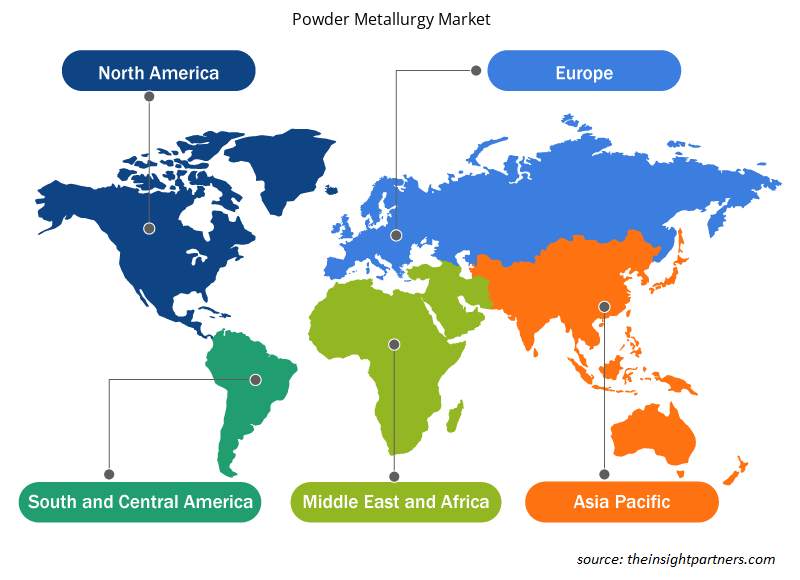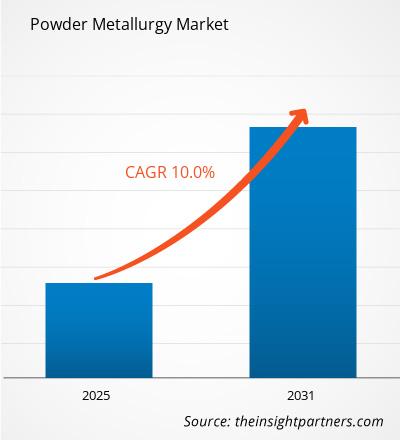Si prevede che il mercato della metallurgia delle polveri registrerà un CAGR del 10% dal 2025 al 2031, con una dimensione di mercato in espansione da XX milioni di dollari USA nel 2024 a XX milioni di dollari USA entro il 2031.
Il rapporto è segmentato per tipo di materiale (ferro, rame, alluminio, acciaio, altri), tecnologia (pressatura e sinterizzazione, stampaggio a iniezione di metallo, pressatura isostatica a caldo, produzione additiva di metallo, altri). Il rapporto presenta inoltre analisi basate sull'applicazione (automotive, elettronica, aerospaziale, medicina, petrolio e gas, altri). L'analisi globale è ulteriormente suddivisa a livello regionale e nei principali paesi. In termini geografici, il mercato è suddiviso in Nord America, Europa, Asia Pacifico, Medio Oriente e Africa e Sud e Centro America). Il rapporto offre il valore in USD per l'analisi e i segmenti di cui sopra.
Scopo del rapporto
Il report Powder Metallurgy Market di The Insight Partners mira a descrivere il panorama attuale e la crescita futura, i principali fattori trainanti, le sfide e le opportunità. Ciò fornirà spunti a vari stakeholder aziendali, come:
- Fornitori/produttori di tecnologia: per comprendere le dinamiche di mercato in evoluzione e conoscere le potenziali opportunità di crescita, consentendo loro di prendere decisioni strategiche informate.
- Investitori: condurre un'analisi completa delle tendenze relative al tasso di crescita del mercato, alle proiezioni finanziarie del mercato e alle opportunità esistenti lungo la catena del valore.
- Enti di regolamentazione: regolamentano le politiche e le attività di controllo sul mercato allo scopo di ridurre al minimo gli abusi, preservare la fiducia degli investitori e sostenere l'integrità e la stabilità del mercato.
Segmentazione del mercato della metallurgia delle polveri
Tipo di materiale
- Ferro
- Rame
- Alluminio
- Acciaio
- Altri
Tecnologia
- Pressa e sinterizzazione
- Stampaggio a iniezione di metallo
- Pressatura isostatica a caldo
- Produzione additiva di metalli
- Altri
Personalizza questo report in base alle tue esigenze
Riceverai la personalizzazione gratuita di qualsiasi report, comprese parti di questo report, o analisi a livello nazionale, pacchetto dati Excel, oltre a usufruire di grandi offerte e sconti per start-up e università
Mercato della metallurgia delle polveri: approfondimenti strategici

-
Scopri le principali tendenze di mercato in questo rapporto.Questo campione GRATUITO includerà analisi di dati che spaziano dalle tendenze di mercato alle stime e alle previsioni.
Fattori di crescita del mercato della metallurgia delle polveri
- Produzione conveniente: rispetto ai processi di produzione classici, la metallurgia delle polveri presenta anche un basso costo di produzione di parti complesse e ad alta precisione. Evita soprattutto materiali non necessari, consuma meno energia e riduce al minimo l'ulteriore lavorazione, il che la rende interessante in settori come l'automobile, l'aerospaziale e l'elettronica.
- Industria automobilistica: un altro settore in cui la metallurgia delle polveri trova un'applicazione sostanziale è l'industria automobilistica, che utilizza la tecnologia per progettare e sviluppare caratteristiche di progettazione che consentono di risparmiare peso nei prodotti ingegnerizzati. Con una tendenza globale verso le auto elettriche e a basso consumo di carburante, sempre più parti di motore, ingranaggi e componenti strutturali sono realizzati con la tecnica della metallurgia delle polveri.
- Progressi nella tecnologia: lo sviluppo del mercato è alimentato dai progressi nella metallurgia delle polveri, tra cui nuovi sistemi di leghe, nuovi metodi di sinterizzazione e metallurgia delle polveri incorporata nella stampa 3D. Tali miglioramenti rendono le parti in metallurgia delle polveri ad alta resistenza e tenacità e ampliano l'uso di questa tecnologia nelle macchine aerospaziali, mediche e industriali.
Tendenze future del mercato della metallurgia delle polveri
- Integrazione con la stampa 3D: uno sviluppo degno di nota è la crescente applicazione dei processi di metallurgia delle polveri nella stampa 3D. La natura della produzione additiva consente la produzione di parti complesse con elevata precisione da modelli 3D, compresi quelli realizzati con metalli in polvere, da qui il crescente utilizzo della metallurgia delle polveri in vari settori come aerospaziale, automobilistico e medico.
-
Rapporto resistenza/peso nell'industria automobilistica e aerospaziale: allo stesso tempo, c'è un'impennata nella necessità per l'industria automobilistica e aerospaziale di incorporare materiali con un elevato rapporto resistenza/peso. La risposta a questa sfida è ovviamente.
Questa sfida è affrontata dall'evoluzione della metallurgia delle polveri, che consente di creare elementi durevoli e leggeri utilizzando il più delle volte nuove leghe e compositi, che aiutano a ridurre il consumo di carburante e a migliorare le prestazioni dei veicoli a motore. - Sostenibilità e produzione ecosostenibile: la metallurgia delle polveri è utile per offrire soluzioni ai processi di produzione ecosostenibili, poiché la consapevolezza del cambiamento climatico rappresenta una minaccia all'uso di questa tecnologia. Il riutilizzo delle polveri metalliche e la riduzione della perdita di materiale in relazione alla crescente domanda di produzione sostenibile rendono la metallurgia delle polveri penggunaan adatta alle tecnologie verdi e alle industrie che devono essere consapevoli del loro impatto sull'ambiente.
Opportunità di mercato della metallurgia delle polveri
- Adozione di veicoli elettrici (EV): la crescente adozione di veicoli elettrici offre un ampio margine per la metallurgia delle polveri. È emersa la necessità di componenti leggeri e ad alta efficienza come motori, ingranaggi e alloggiamenti per batterie, che sono adatti alla produzione in serie di parti convenienti e resistenti, stimolando così la crescita del mercato.
- Applicazioni aerospaziali e marine: la capacità della metallurgia delle polveri di realizzare componenti altamente intricati ed esatti crea una nicchia di mercato nella produzione di prodotti aerei e marini. Giunti di alto valore, peso ridotto e resistenti al calore come pale di turbine, parti strutturali e cuscinetti e ingranaggi hanno reso la metallurgia delle polveri un processo di produzione fondamentale per queste industrie.
- Produzione di dispositivi medici: il mercato in espansione dei dispositivi medici crea finestre attraverso cui la metallurgia delle polveri può innovare, specialmente nello sviluppo di impianti e attrezzature chirurgiche resistenti e su misura. Tale processo è efficace nella produzione di dispositivi medici ortopedici grazie alla sua capacità di fabbricare forme complesse utilizzando materiali biocompatibili.
Approfondimenti regionali sul mercato della metallurgia delle polveri
Le tendenze regionali e i fattori che influenzano il mercato della metallurgia delle polveri durante il periodo di previsione sono stati ampiamente spiegati dagli analisti di Insight Partners. Questa sezione discute anche i segmenti e la geografia del mercato della metallurgia delle polveri in Nord America, Europa, Asia Pacifico, Medio Oriente e Africa e Sud e Centro America.

- Ottieni i dati specifici regionali per il mercato della metallurgia delle polveri
Ambito del rapporto di mercato sulla metallurgia delle polveri
| Attributo del report | Dettagli |
|---|---|
| Dimensioni del mercato nel 2024 | XX milioni di dollari USA |
| Dimensioni del mercato entro il 2031 | XX milioni di dollari USA |
| CAGR globale (2025 - 2031) | 10% |
| Dati storici | 2021-2023 |
| Periodo di previsione | 2025-2031 |
| Segmenti coperti |
Per tipo di materiale
|
| Regioni e Paesi coperti |
America del Nord
|
| Leader di mercato e profili aziendali chiave |
|
Densità degli attori del mercato della metallurgia delle polveri: comprendere il suo impatto sulle dinamiche aziendali
Il mercato della metallurgia delle polveri sta crescendo rapidamente, spinto dalla crescente domanda degli utenti finali dovuta a fattori quali l'evoluzione delle preferenze dei consumatori, i progressi tecnologici e una maggiore consapevolezza dei benefici del prodotto. Con l'aumento della domanda, le aziende stanno ampliando le loro offerte, innovando per soddisfare le esigenze dei consumatori e capitalizzando sulle tendenze emergenti, il che alimenta ulteriormente la crescita del mercato.
La densità degli operatori di mercato si riferisce alla distribuzione di aziende o società che operano in un particolare mercato o settore. Indica quanti concorrenti (operatori di mercato) sono presenti in un dato spazio di mercato in relazione alle sue dimensioni o al valore di mercato totale.
Le principali aziende che operano nel mercato della metallurgia delle polveri sono:
- ELETTRICA GENERALE
- Società quotata in borsa CRS Holdings Inc.
- ExOne GmbH
- Società per azioni Melrose
- AB di Höganäs
Disclaimer : le aziende elencate sopra non sono classificate secondo un ordine particolare.

- Ottieni una panoramica dei principali attori del mercato della metallurgia delle polveri
Punti di forza chiave
- Copertura completa: il rapporto copre in modo completo l'analisi di prodotti, servizi, tipologie e utenti finali del mercato della metallurgia delle polveri, fornendo una panoramica olistica.
- Analisi degli esperti: il rapporto è compilato sulla base della conoscenza approfondita di esperti e analisti del settore.
- Informazioni aggiornate: il rapporto garantisce la pertinenza aziendale grazie alla copertura di informazioni recenti e tendenze nei dati.
- Opzioni di personalizzazione: questo report può essere personalizzato per soddisfare le esigenze specifiche del cliente e adattarsi in modo appropriato alle strategie aziendali.
Il rapporto di ricerca sul mercato della metallurgia delle polveri può, quindi, aiutare a guidare il percorso di decodificazione e comprensione dello scenario del settore e delle prospettive di crescita. Sebbene possano esserci alcune preoccupazioni valide, i vantaggi complessivi di questo rapporto tendono a superare gli svantaggi.
- Analisi storica (2 anni), anno base, previsione (7 anni) con CAGR
- Analisi PEST e SWOT
- Valore/volume delle dimensioni del mercato - Globale, Regionale, Nazionale
- Industria e panorama competitivo
- Set di dati Excel
Report recenti
Testimonianze
Motivo dell'acquisto
- Processo decisionale informato
- Comprensione delle dinamiche di mercato
- Analisi competitiva
- Analisi dei clienti
- Previsioni di mercato
- Mitigazione del rischio
- Pianificazione strategica
- Giustificazione degli investimenti
- Identificazione dei mercati emergenti
- Miglioramento delle strategie di marketing
- Aumento dell'efficienza operativa
- Allineamento alle tendenze normative






















 Ottieni un campione gratuito per - Mercato della metallurgia delle polveri
Ottieni un campione gratuito per - Mercato della metallurgia delle polveri